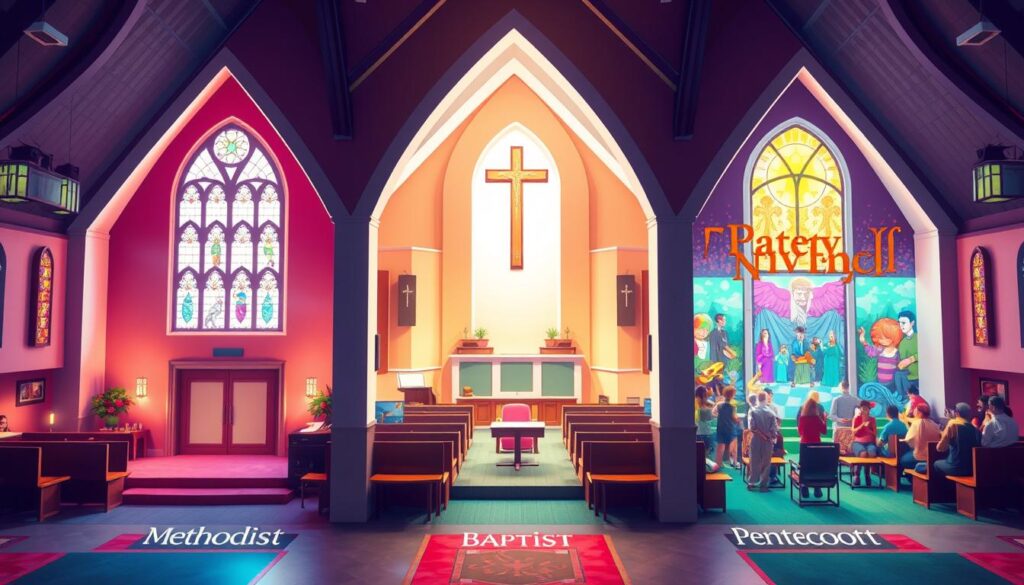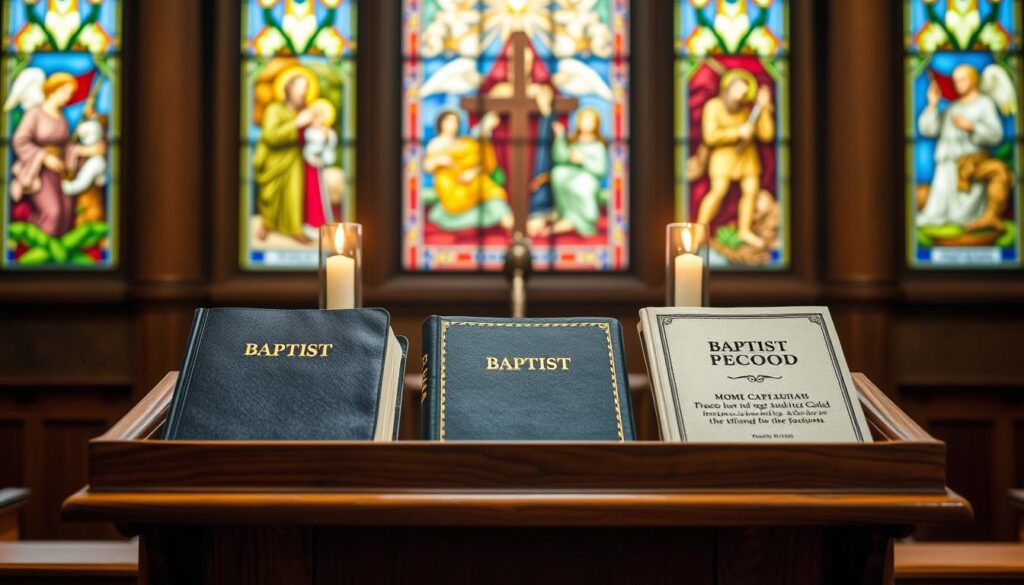What makes the Methodist, Baptist, and Pentecostal denominations unique in American Christianity? They differ in beliefs, practices, and how they run their churches. These differences have shaped American Christianity for centuries. Understanding these differences helps us see the rich variety of Christian traditions in the U.S.


Transform Your Faith Journey: Explore Our Engaging Bible Study eBooks
Key Takeaways
- Baptists are the biggest Protestant group in the U.S, with the Southern Baptist Convention leading way
- Methodist groups started in the 18th century with John Wesley’s evangelical movement.
- Methodists and Baptists have different beliefs on salvation, the Trinity, and sacraments.
- Pentecostals focus on the Holy Spirit’s baptism and spiritual gifts.
- These denominations also differ in how they govern their churches, ordain leaders, and influence society.
Introduction to Methodist, Baptist, and Pentecostal Denominations
The Methodist, Baptist, and Pentecostal denominations are three main branches of protestant christianity. Each has its own history, beliefs, and structure. These differences make the overview of methodist baptist pentecostal denominations diverse.
Brief Overview of the Three Christian Faiths
Methodism started with John Wesley in the 18th century. It stresses personal holiness and helping others. Baptists go back to the 16th-century Reformation, valuing the Bible and local church freedom. Pentecostalism, a 20th-century movement, highlights the work of the Holy Spirit and charismatic spiritual experiences.
Historical Background and Origins
The historical origins of these groups are tied to protestant christianity. Methodism sprang from the Anglican Church, while Baptists and Pentecostals formed as distinct groups within Protestantism. Each has its own denominational differences and historical origins, shaping their beliefs and practices today.
“The rapid growth of Pentecostalism is evident in many parts of the world, especially in the Global South and Third World countries.”
Beliefs and Doctrines
The Methodist, Baptist, and Pentecostal denominations have their own beliefs and teachings. These beliefs shape how they see salvation, grace, and the Trinity. Each group has its own way of understanding these important Christian concepts.
Views on Salvation and Grace
Methodists believe grace is key to salvation. They talk about prevenient, justifying, and sanctifying grace. They say God’s grace comes first, helping people respond and leading to salvation.
Baptists believe in “sola fide,” or salvation through faith alone. They don’t focus as much on the different stages of grace. Pentecostals have different views, with some seeing baptism in the Holy Spirit as a special experience after conversion.
Understanding of the Trinity
All three denominations believe in the Trinity. They see God as one being in three persons: the Father, the Son, and the Holy Spirit. This belief unites them, even if they differ in other beliefs and practices.
| Denomination | Membership Size | Views on Baptism | Beliefs on Christian Perfection |
|---|---|---|---|
| Methodist | 100,000,000 | Baptism should be by immersion as a public demonstration of one’s new life in Christ. | Christians can never become sinless in this earthly life. |
| Baptist | 80,000,000 | Baptism should be by sprinkling water on the head, as the first sacrament of Christian initiation, cleansing from all sins. | Christians can become evangelically perfect through sanctification. |
| Pentecostal | N/A | Baptism is associated with adult believers, often through full immersion. | N/A |
These denominations have different beliefs and teachings. Their unique views and histories add to the variety in Protestant Christianity.

“The Trinity is a central belief that unites the Methodist, Baptist, and Pentecostal denominations, despite their other theological differences.”
Worship Practices and Styles
Methodist, Baptist, and Pentecostal denominations have different worship styles. These differences show their unique beliefs and histories.
Methodists prefer a liturgical approach to worship. They use traditional hymns, prayers, and honor the sacraments. Their services often talk about holiness, entire sanctification, and perfection. This comes from their Wesleyan roots.
Baptists have a simpler worship service. They focus on preaching and the ordinances of baptism and communion. Their services are less structured, putting a lot of emphasis on the Word of God.
Pentecostals are known for their passionate and spirit-filled worship. Their services often include speaking in tongues, prophetic utterances, and spontaneous expressions of praise. This shows their belief in the power of the Holy Spirit and the charismatic gifts.
These different worship styles show the wide range of beliefs in Christianity. Each denomination has its own way of understanding God, the Holy Spirit, and what it means to be a Christian.
Methodist vs Baptist vs Pentecostal: Key Differences
Methodists, Baptists, and Pentecostals are all Protestant Christian groups. Yet, they have big differences in their beliefs, how they practice their faith, and their church structure. These differences show how diverse Christianity can be.
Church Governance and Authority
The Methodist church has a top-down structure with elders, deacons, and bishops. They oversee different levels, like districts and conferences. This structure helps unite Methodists worldwide. Baptists, however, believe in a bottom-up approach. They think the local church makes all the decisions. This way, Baptist churches can join together voluntarily.
Sacraments and Ordinances
Methodists see Baptism and the Lord’s Supper as ways to share grace. Baptists see them as symbols but not as sharing grace. They believe in full immersion for baptism and the Lord’s Supper as a reminder of Jesus.
Perspectives on Salvation and Grace
Methodists believe in different kinds of grace, like prevenient, justifying, and sanctifying grace. They see salvation as a journey towards being holy. Baptists have different views, with some believing in a secure salvation and others seeing it as conditional.
Worship Styles and Practices
Baptist services are often simple, focusing on the sermon. Methodists prefer more structured worship with hymns, prayers, and Holy Communion.
Social and Cultural Influences
Methodists tend to be moderate on social issues, supporting women in leadership and social justice. Baptists are often more conservative, limiting women’s roles in ministry.
Even with their differences, Methodists, Baptists, and Pentecostals all believe in key Christian teachings like the Trinity. They each have their own way of expressing their faith.
| Denomination | Church Governance | Sacraments/Ordinances | Salvation and Grace | Worship Practices | Social Engagement |
|---|---|---|---|---|---|
| Methodist | Hierarchical with elders, deacons, and bishops | Baptism and Lord’s Supper as sacraments | Nuanced view with different types of grace, emphasis on progression towards holiness | Structured, liturgical worship with hymns, prayers, and Holy Communion | Moderate stance, allowing women in leadership, active in social justice |
| Baptist | Congregationalist, with authority vested in the local church | Baptism and Lord’s Supper as ordinances, not sacraments | Diverse perspectives, ranging from Calvinistic to Arminian theology | Simpler services focused on preaching | Often socially conservative, with limited roles for women in ministry |
| Pentecostal | Varied, with some denominations more centralized and others decentralized | Emphasis on baptism in the Holy Spirit and manifestation of spiritual gifts | Focus on the power of the Holy Spirit, belief in divine healing and miracles | Charismatic, with emphasis on spiritual experiences, speaking in tongues, and exuberant worship | Diverse, ranging from socially conservative to progressive on various issues |

The differences between Methodists, Baptists, and Pentecostals show the wide range within Protestant Christianity. They highlight the unique beliefs and practices of each group.
Church Governance and Structure
The Methodist and Baptist denominations have different ways of running their churches. Methodists use a “connectional” system, with a clear hierarchy from local churches to a general conference. Baptist churches are more congregationalist, giving each local church its own power.
Methodists have a special clergy setup with bishops, elders, and deacons. Baptists have pastors and deacons. These differences show how these two big Protestant groups see things differently.
Methodist Church Polity
John Wesley started the Methodist church in the late 1700s. It has an episcopal form of governance. This means Methodist churches are linked in a clear hierarchy, with districts, annual conferences, and a general conference at the top. Bishops lead the annual conferences and help with spiritual and administrative tasks.
Baptist Church Governance
Baptist churches follow a congregationalist model, where each church makes its own decisions. There’s no big denominational structure like the Methodists have. Baptist governance puts the local church first, with the pastor and deacons leading in both church matters and spiritual guidance.
These differences show how the Methodist and Baptist traditions are rooted in different beliefs and histories. They affect how they govern and structure their churches.
Sacraments and Ordinances
Methodists and Baptists have different views on methodist sacraments and baptist ordinances. They both respect the Bible deeply. Yet, they see the means of grace in different ways.
Methodists and the Two Sacraments
Methodists believe in two sacraments: baptism and Holy Communion. They think these sacraments are key ways God gives grace to believers. Baptism symbolizes spiritual cleansing and rebirth. Holy Communion is seen as a way to spiritually feed and remember Christ’s sacrifice.
Baptists call these acts ordinances, not sacraments. They see them as signs of a believer’s commitment to Christ. Baptists believe salvation comes only through faith. The ordinances are outward signs of that faith.
“Methodists see the sacraments as a means of grace, while Baptists view them as symbolic ordinances. This theological differences highlights the distinct ways these denominations approach the role of methodist sacraments and baptist ordinances in the life of the believer.”

Methodist, Baptist and Pentecostal: Spiritual Gifts and Charismatic Expressions
Pentecostal View on Spiritual Gifts
Pentecostalism is known for its focus on spiritual gifts like speaking in tongues, prophecy, and healing. They believe all spiritual gifts mentioned in the New Testament are still active today. This view makes Pentecostalism stand out from other denominations like Methodist and Baptist, which have different views on these gifts and expressions.
About 25% of the world’s Christians identify as Pentecostal or Charismatic. There are over 11,000 different Pentecostal or Charismatic denominations around the globe. In the US, over 20 million people follow Pentecostalism, and the number could be as high as 600 million worldwide.
The charismatic movement started in 1906 with the Azusa Street Revival. This event marked the beginning of Pentecostalism in the US and worldwide. The Yoido Full Gospel Church in South Korea had 780,000 members in 2003, showing how Pentecostalism has grown and spread.
Pentecostalism is seen as the “third force of Christianity.” It focuses on prophetic utterances and glossolalia, or speaking in tongues, during worship. The Pentecostal and Charismatic Renewal (PCR) movement makes up 25%-30% of world Christianity. This makes it a big and influential part of Christianity.
“The Azusa Street Revival in 1906 is considered the starting point of the Pentecostal movement in the US and globally.”
Views on Baptism and Its Significance
Methodists, Baptists, and Pentecostals have different views on baptism. Methodists believe in infant baptism. They see it as a way to welcome children into the Christian faith. Baptists, however, believe in believer’s baptism. This means people get baptized after they make a personal choice to follow Christ.
Pentecostals think baptism by immersion is important. They see it as a way to show publicly that they believe in Christ. This act symbolizes their connection to Christ’s death, burial, and rising again.
- Baptists don’t call them sacraments but “ordinances.” They believe in water baptism by immersion and the Lord’s Supper. They rarely baptize infants.
- Methodists see Baptism and the Lord’s Supper as sacraments. They help people receive grace. They baptize both infants and adults.
- Methodists believe Baptism with the Holy Spirit is about being fully saved. Pentecostals link it with speaking in tongues.
These differences in how they view mode of baptism, significance of baptism, and timing of baptism set apart Methodist, Baptist, and Pentecostal beliefs.

“Baptism is a sacrament of the church, a means of grace, and a sign of the covenant. It is a symbol of our participation in Christ’s death and resurrection, the outward and visible sign of the inward and spiritual grace of regeneration and rebirth.” – The United Methodist Church
Perspectives on Sanctification and Christian Perfection
Methodists, Baptists, and Pentecostals have different views on sanctification and Christian perfection. Methodists see sanctification as a gradual process. They believe believers get closer to being like Christ over time. Some Pentecostals aim for Christian perfection or sinless living now. Baptists see sanctification as a slow process without focusing on perfection.
John Wesley, the founder of Methodism, taught that sanctification happens in two stages. First, a person becomes a Christian. Then, they start to become more like Christ. This idea is part of the Holiness movement, which started in the 19th century. It says believers can be fully sanctified, free from original sin, in one moment.
Baptists believe in a gradual sanctification without the goal of perfection. The Reformed view also sees sanctification as ongoing. It says all Christians are being made holy, but there are differences between being justified and being sanctified.
Pentecostalism, starting in 1900, emphasizes Spirit-baptism as a key event for believers. But, Pentecostals disagree on when this baptism happens and its link to sanctification. The Chaferian view says Spirit-baptism is at conversion, fitting into three categories: natural, carnal, and spiritual.
The Roman Catholic Church believes in Christian perfection as a spiritual bond with God. They say it’s possible in this life, but not perfect because of human flaws. The goal is to be united with God, first by grace on earth and then fully in heaven.
These views show the varied beliefs on sanctification and Christian perfection among Methodists, Baptists, Pentecostals, and Catholics. They reveal the deep theological differences within Christianity.
READ: BSF Lesson 20 Day 2
“The terms ‘perfect’ and ‘perfection’ are drawn from the Greek teleios and teleiōsis, respectively, with teleiōsis also referring to personal wholeness or health.”
Scriptural Interpretation and Authority
Methodist, Baptist, and Pentecostal churches have different views on the Bible’s authority and meaning. Baptists believe in sola scriptura, meaning the Bible alone is their guide. Methodists, on the other hand, use the Bible first but also value tradition, experience, and reason.
Sola Scriptura vs. Prima Scriptura
Baptists stick to sola scriptura. They think the Bible is the only authority for faith and life. Methodists, however, see the Bible as the main guide but also look to tradition, reason, and experience for understanding.
The Global Methodist Church is a new group that mixes sola scriptura and prima scriptura. They see ancient creeds like the Apostle’s Creed as important, along with the Bible.
| Denomination | Approach to Scriptural Authority |
|---|---|
| Baptists | Sola Scriptura (Scripture alone) |
| Methodists | Prima Scriptura (Scripture as primary, with tradition, reason, and experience) |
| Global Methodist Church | Blend of sola scriptura and prima scriptura, with additional emphasis on ecumenical creeds |
There’s a big debate on how to understand the methodist baptist pentecostal bible. Some want to focus more on Jesus’ Resurrection in theology.

Social and Cultural Influences
The Methodist, Baptist, and Pentecostal denominations have made big marks on American Christianity. Baptists often lean towards being socially and politically conservative. They stick to traditional values and moral views.
Methodists, however, usually take a middle ground or a progressive view. They support women’s roles in the church, social justice, and ethical debates.
Pentecostals vary in their views, from very conservative to more open-minded. The African Methodist Episcopal (AME) Church and the AME Zion Church have grown a lot. They started with about 1,000 members in 1816 and now have over 450,000 by 1896. They moved north and west as African Americans moved.
| Denomination | Social and Cultural Influence |
|---|---|
| Baptists | Tend to be more socially and politically conservative, aligning with traditional values and moral stances. |
| Methodists | Often take a more moderate or progressive stance on issues like women’s roles in the church, social justice, and moral/ethical questions. |
| Pentecostals | Display a wide range of perspectives, from conservative to more progressive, depending on the specific branch or congregation. |
These denominations have greatly influenced American society. Baptists, Methodists, and Pentecostals have shaped the nation’s social issues, cultural values, and political stances. The progressive vs conservative debate within them adds to the variety of American Christianity.
“Baptists, Methodists, and Pentecostals have deeply influential theological and social impact in American society.”
Methodist, Baptist and Pentecostal: Similarities and Points of Convergence
Methodist, Baptist, and Pentecostal denominations have many common beliefs despite their differences. They all stand on a Protestant Christian base. They believe in the Holy Trinity, Christ’s divinity, and salvation through faith in Jesus.
They all value the Bible highly. Even with different views, they see the Bible as key to their beliefs and actions. This shared respect for the Bible helps unite them, even with their theological overlap and shared beliefs between Methodist Baptist Pentecostal traditions.
These denominations also stress the need for personal salvation, repentance, and conversion. They believe in a deep relationship with Jesus Christ and the Holy Spirit’s power in believers’ lives. This shared view on salvation and the Holy Spirit’s role shows a shared theological base, beyond their common ground between Methodist Baptist Pentecostal differences.
| Denomination | Shared Beliefs | Theological Overlap |
|---|---|---|
| Methodist | – Authority of the Bible – Importance of personal salvation – Role of the Holy Spirit | – Emphasis on grace and sanctification – Belief in the Trinity |
| Baptist | – Authority of the Bible – Importance of personal salvation – Believer’s baptism | – Sola Scriptura principle – Autonomy of local churches |
| Pentecostal | – Authority of the Bible – Importance of personal salvation – Emphasis on the Holy Spirit and spiritual gifts | – Charismatic expressions – Belief in divine healing and miracles |
Though the common ground between Methodist Baptist Pentecostal traditions might not be obvious, these shared beliefs and theological overlap lay a foundation for dialogue and cooperation among these Christian denominations.
“The Convergence Movement seeks to blend or merge essential elements historically represented by three major streams of thought and practice: Charismatic, Evangelical/Reformed, and Liturgical/Sacramental.”
Methodist vs Baptist vs Pentecostal: Controversial and Debated Issues
The Methodist, Baptist, and Pentecostal denominations share many beliefs. Yet, they also have debated issues. These include women’s roles in leadership, speaking in tongues, baptism, eternal security, and interpreting certain passages.
Over two centuries, the United Methodist Church has seen a decline in discipline and doctrine. In the 19th century, issues like slavery and racism led to moral decline. By 1913, the Methodist Episcopal Church faced criticism for embracing liberal theologies, moving away from biblical teachings.
By 1920, modernism took over Methodism, pushing traditional beliefs aside. The Good News movement started in 1966 to uphold orthodox beliefs. But, divisions continued, with some leaders denying core Christian teachings.
Today, the United Methodist Church is facing a split. This is due to past failures in discipline and doctrine, with homosexuality being one issue.
| Controversial Topic | Methodist Perspective | Baptist Perspective | Pentecostal Perspective |
|---|---|---|---|
| Role of Women in Church Leadership | Diverse views, with some denominations ordaining women as clergy | Predominantly conservative, with some exceptions allowing women in leadership roles | Mixed, with some Pentecostal denominations ordaining women, while others maintain more traditional views |
| Speaking in Tongues | Not a universally accepted practice, with some Methodist churches allowing it | Generally not a widespread practice, viewed as a less essential spiritual gift | Central to Pentecostal theology and worship, seen as a sign of the baptism of the Holy Spirit |
| Interpretation of Scripture | Diverse, ranging from more liberal to more traditional approaches | Generally more literal and conservative interpretation of the Bible | Diverse, with some Pentecostal denominations embracing a more literal interpretation, while others allow for a more dynamic and experiential approach |
These debates and questions shape the relationships between the Methodist, Baptist, and Pentecostal denominations. They show the diversity and complexity within Christianity.
Conclusion
The Methodist, Baptist, and Pentecostal denominations in American Christianity have their own beliefs and ways of worship. They all come from Protestant Christianity but have many differences. These differences show in their beliefs, doctrines, and how they practice their faith.
Understanding the differences between Methodists, Baptists, and Pentecostals helps us see how diverse American Protestantism is. They have different views on salvation, grace, and how they worship and govern their churches. Each brings something unique to the Christian faith.
By looking at these denominations, we learn more about American religious traditions. This helps us connect better with the many ways Christians express their faith. The study of these denominations encourages open talks among believers. It helps us value the unique aspects and common values of the Methodist, Baptist, and Pentecostal faiths.
FAQ
What are the key differences between the Methodist, Baptist, and Pentecostal denominations?
Methodists focus on grace in salvation. Baptists believe in salvation through faith alone. Pentecostals highlight the Holy Spirit and spiritual experiences.
What are the historical origins and background of these three Christian faiths?
Methodism started with John Wesley in the 18th century. Baptists go back to the 16th-century Reformation. Pentecostalism began in the early 1900s, focusing on the Holy Spirit and spiritual gifts.
How do the denominations differ in their views on the Trinity?
All three believe in God as one being in three persons: Father, Son, and Holy Spirit.
What are the differences in worship styles among the Methodist, Baptist, and Pentecostal churches?
Methodists prefer a more formal worship. Baptists focus on simple, direct worship with a lot of preaching. Pentecostals have lively, spirit-filled services that might include speaking in tongues.
How do the denominations differ in their church governance and structure?
Methodists have a structured system with bishops and elders. Baptists are more local, with each church in charge of itself. Methodists have a clergy system, while Baptist churches have only pastors and deacons.
What are the differences in the understanding and practice of the sacraments or ordinances?
Methodists see two sacraments: baptism and Holy Communion. Baptists view these as symbols, not sources of grace.
How do the denominations differ in their views on spiritual gifts and charismatic expressions?
Pentecostals believe in many spiritual gifts, like speaking in tongues. Methodists and Baptists have different views on these gifts.
What are the differences in the denominations’ views on baptism and its significance?
Methodists baptize infants. Baptists baptize believers. Pentecostals often baptize by immersion as a sign of faith.
How do the denominations differ in their perspectives on sanctification and Christian perfection?
Methodists see sanctification as a gradual process. Some Pentecostals aim for Christian perfection. Baptists believe in a slower process of becoming holy.
What are the differences in the denominations’ approaches to the authority and interpretation of the Bible?
Baptists focus on the Bible alone. Methodists use the Bible first but also consider tradition and reason.
How do the denominations differ in their social and cultural influences within American Christianity?
Historically, Baptists were socially and politically conservative. Methodists often took a middle ground on issues like women’s roles and social justice. Pentecostals have varied views, from conservative to progressive.

